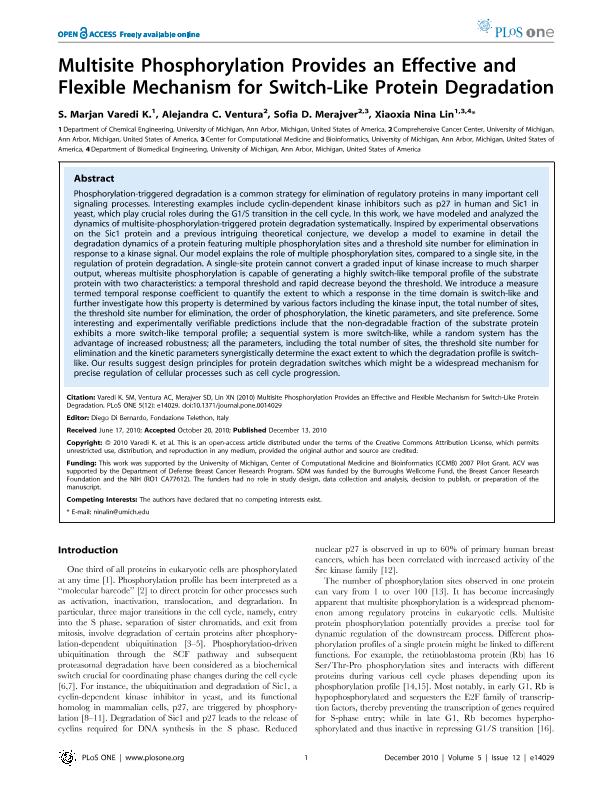Mostrar el registro sencillo del ítem
dc.contributor.author
Varedi, Marjan K. S.
dc.contributor.author
Ventura, Alejandra

dc.contributor.author
Merajver, Sofia D.
dc.contributor.author
Lin, Xiaoxia Nina
dc.date.available
2017-07-13T15:16:22Z
dc.date.issued
2010-12
dc.identifier.citation
Varedi, Marjan K. S.; Ventura, Alejandra; Merajver, Sofia D.; Lin, Xiaoxia Nina; Multisite phosphorylation provides an effective and flexible mechanism for switch-like protein degradation; Public Library of Science; Plos One; 5; 12; 12-2010; 1-18; e14029
dc.identifier.issn
1932-6203
dc.identifier.uri
http://hdl.handle.net/11336/20334
dc.description.abstract
Phosphorylation-triggered degradation is a common strategy for elimination of regulatory proteins in many important cell signaling processes. Interesting examples include cyclin-dependent kinase inhibitors such as p27 in human and Sic1 in yeast, which play crucial roles during the G1/S transition in the cell cycle. In this work, we have modeled and analyzed the dynamics of multisite-phosphorylation-triggered protein degradation systematically. Inspired by experimental observations on the Sic1 protein and a previous intriguing theoretical conjecture, we develop a model to examine in detail the degradation dynamics of a protein featuring multiple phosphorylation sites and a threshold site number for elimination in response to a kinase signal. Our model explains the role of multiple phosphorylation sites, compared to a single site, in the regulation of protein degradation. A single-site protein cannot convert a graded input of kinase increase to much sharper output, whereas multisite phosphorylation is capable of generating a highly switch-like temporal profile of the substrate protein with two characteristics: a temporal threshold and rapid decrease beyond the threshold. We introduce a measure termed temporal response coefficient to quantify the extent to which a response in the time domain is switch-like and further investigate how this property is determined by various factors including the kinase input, the total number of sites, the threshold site number for elimination, the order of phosphorylation, the kinetic parameters, and site preference. Some interesting and experimentally verifiable predictions include that the non-degradable fraction of the substrate protein exhibits a more switch-like temporal profile; a sequential system is more switch-like, while a random system has the advantage of increased robustness; all the parameters, including the total number of sites, the threshold site number for elimination and the kinetic parameters synergistically determine the exact extent to which the degradation profile is switchlike. Our results suggest design principles for protein degradation switches which might be a widespread mechanism for precise regulation of cellular processes such as cell cycle progression. © 2010 Varedi K. et al.
dc.format
application/pdf
dc.language.iso
eng
dc.publisher
Public Library of Science

dc.rights
info:eu-repo/semantics/openAccess
dc.rights.uri
https://creativecommons.org/licenses/by-nc-sa/2.5/ar/
dc.subject
Cellular Signaling
dc.subject
Mathematical Modeling
dc.subject
Signal Transduction
dc.subject.classification
Otras Ciencias Físicas

dc.subject.classification
Ciencias Físicas

dc.subject.classification
CIENCIAS NATURALES Y EXACTAS

dc.title
Multisite phosphorylation provides an effective and flexible mechanism for switch-like protein degradation
dc.type
info:eu-repo/semantics/article
dc.type
info:ar-repo/semantics/artículo
dc.type
info:eu-repo/semantics/publishedVersion
dc.date.updated
2017-07-12T14:52:29Z
dc.journal.volume
5
dc.journal.number
12
dc.journal.pagination
1-18; e14029
dc.journal.pais
Estados Unidos

dc.journal.ciudad
San Francisco
dc.description.fil
Fil: Varedi, Marjan K. S.. University of Michigan; Estados Unidos
dc.description.fil
Fil: Ventura, Alejandra. University of Michigan; Estados Unidos. Consejo Nacional de Investigaciones Científicas y Técnicas; Argentina
dc.description.fil
Fil: Merajver, Sofia D.. University of Michigan; Estados Unidos
dc.description.fil
Fil: Lin, Xiaoxia Nina. University of Michigan; Estados Unidos
dc.journal.title
Plos One

dc.relation.alternativeid
info:eu-repo/semantics/altIdentifier/doi/http://dx.doi.org/10.1371/journal.pone.0014029
dc.relation.alternativeid
info:eu-repo/semantics/altIdentifier/url/http://journals.plos.org/plosone/article?id=10.1371/journal.pone.0014029
Archivos asociados
